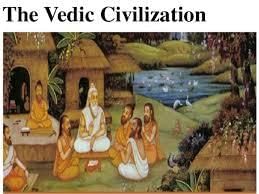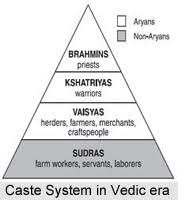ANCIENT HISTORY CONTINUED..... | Additional Study Material for UPSC PDF Download
#4) VEDIC LITERATURE AND CIVILISATION-
Vedas derived from Sanskrit word 'Vid ' , means to know.
As I mentioned in the last last article that Aryans came after IVC , so Aryan were fair complexioned people who were engaged in agriculture. Now where did they come from?There are different stories on the arrival of Aryans , i.e, They came from Europe/ Germany/ Tibet etc. But the most accepted theory is by Max Muller who stated that they came from Central Asia( Kazakhstan, Kyrgyzstan, Tajikistan , Turkmenistan, Uzbekistan ).
So, Vedic Age , is categorized into 2-
EARLY/ RIGVEDIC PERIOD - when Rigveda was written ( 1500-1000 BC)
Early Aryans were seminomadic ( banjaare) .

They used to domesticate animals . They had a tribe with a chief as a protector of the tribe. Tribe's identity was based on their tribe only, not related to any place they live in.
Chief received a tax from people- BALI/BHAGA (1/6th of what was produced.)
Chief priest - Hotri
They worshipped NATURE
(BHAGVAAN - BHOODEV, GAGAN , VAAYU, AGNI, NEER or in other words we can say Earth, Atmosphere, Air, Fire, Water)
They used to have 2 drinks
* Soma - intoxicant drink , drunk at sacrifices . ( religious)
*Sura - purely secular and more potent , non religious
Family- Patriarchal ( desire to have son)
Types of marriages-
*Anulome( girl lower caste, boy upper)+ Pratilome (girl upper caste, boy lower )= Chandal was the name given to their Children.
*Brahma ( girl and boy both from same class ).
Cow was considered as a sign of wealth, given as gifts and was worshipped.
Womem were respectable, widow remarriage was allowed.
concept of 1 God was followed ( monotheism).
LATER VEDIC AGE- other 3 vedas were written - Yajur Veda , Sam Veda, Atharv Veda (1000-600BC).
Agriculture production was increased.
Iron was discovered. Education was called as UPANAYAN
Royal power of kings was increased.
Society was divided into 4 castes-
#BRAHMANS- best of all. they used to study and teach vedas.

#KSHATRIYAS-rajas. used to fight battles and protect people.
#VAISHYAS- used to deal in agriculture and trade. could perform sacrifices.
#SHUDRAS- used to serve the other 3 groups . couldn't be educated.couldn't perform any rituals.
Later vedas had Varna System- an ideal order of life..with a human life span of 100 years...
#BRAHMACHARYA - 25 YEARS
#GRIHASTA- 25 YEARS
#VANAPRASTHA- 25 YEARS
#SANYASA- 25 YEARS
society was Patriarchal ( eldest son is head), patrilineal( after death son will take over), Patrilocal (girl will leave house after wedding).
Daughter's birth was curse.
agriculture was developed.
Cow - worshipped.
Trade developed- Cotton industry.
Barter system - ( trade by exchange of commodities rather than exchange of money.)
Gods were divided.
Rin (Debt)- Pitrarin ( father), Rishi rin( guru), Dev rin ( God).
theory of Karma was followed..
VEDIC LITERATURE
Divided into 2-
SRUTI LIERATURE- audit by God - vedas , brahmanas , upanishads , arankyas (based on hearing)
SMRITI LITERATURE- Teacher disciple relation (based on memory /retention)
* RIG VEDA- oldest
priest - hotri
1028 hymns
9th - dedicated to soma
10th- contains famous Purushukta hymn ( explains the origin of 4 varnas- vertical caste system)
contains Gayatri Mantra - addressed to Goddess Savitri.
*YAJUR VEDA- priest- adhvaryu
all sacrificial prayers.
*SAMA VEDA- priest - uggaitar( collection of melodies).
1st evidence of study of music in India.
*ATHARVA VEDA- book of magical formulas(non aryan practice).
*BRAHMANAS-commentaries on Vedas. eg, Rigveda- Aitrya brahmana( soma sacrifice)
*UPANISHADS- mostly in dialogue form( guru shishya)
eg - Kathopanishad- dialogue between a student Nachiketa and lord Yama ( God of death).
Mundak Upanishad- Satyamev Jayate word , part of national emblem
*EPICS-
RAMAYANA - older, by Balmiki , contains 24000 shlokas in Sanskrit.
MAHABHARTA -oldest, largest by Ved Vyas
Earlier called as Jaya Samhita , Akbar got it translated into Persion called as Razamnamah.
1st book Bharata , then came Mahabharta.
DECLINE REASONS-
very complex religion.
Brahmans supremacy.
desire of Vaishyas to improve their social position.
During Vedic period, the language used was Pali, but Brahmans gave importance to Sanskrit.
|
21 videos|562 docs|160 tests
|
















